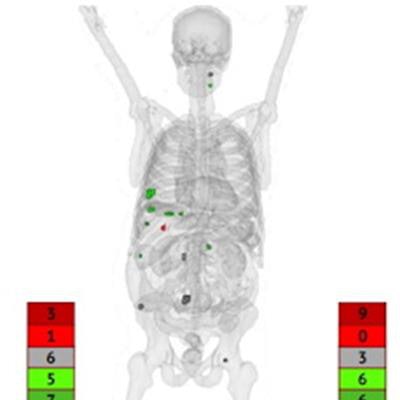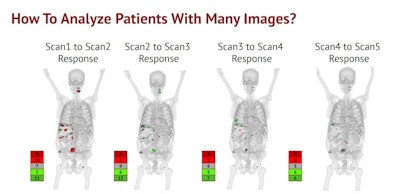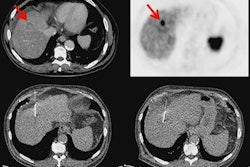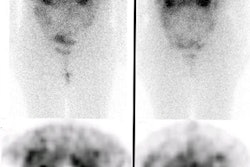
Artificial intelligence (AI)-based analysis of PET/CT exams can aid in long-term tracking of patients receiving treatment for neuroendocrine cancer, according to a presentation at this week's Society of Nuclear Medicine and Molecular Imaging (SNMMI) meeting.
Researchers led by Amy Weisman, PhD, a medical physicist at the University of Wisconsin-Madison and lead project scientist for software developer AIQ Solutions, trained a fully automated software application to evaluate lesion response over the course of neuroendocrine cancer treatment with Lutetium-177 DOTATATE (Lutathera, Novartis). They found that the software identified hundreds of lesions that had completely resolved as well as hundreds of new lesions.
Lutathera was approved in 2018 for treating patients with advanced neuroendocrine cancer. The drug prolongs survival, yet many patients exhibit therapy-resistant lesions and heterogeneous response, which can be difficult to characterize over time on PET/CT imaging.
"In order to fully capture and understand how the disease is changing, we need to be able to do this automatically," Weisman said.
To train their AI algorithm, Weisman and colleagues utilized 81 sequential gallium-68 DOTATATE PET/CT images from 25 patients treated at the University of Wisconsin-Madison, with a range of two to seven images per patient. Twelve patients had three or more images, which allowed for a longer-term response assessment, Weisman said.
The researchers used an ensemble of convolutional neural networks to automatically identify and segment suspicious regions of interest, which were then localized and quantified based on total Ga-68 DOTATATE radiotracer standard uptake values (SUVtotal).
Images from multiple timepoints are then registered together so that lesions can be identified across time. Then, based on changes of plus or minus 30% in SUVtotal per lesion, the model classifies the tumors as new, progressing, stable, responding, or completely responding.
"This can then be used to determine the proportions of lesions in each response category for a single response assessment," Weisman said.
Using the model to analyze the images across all patients, the researchers found 523 lesions were completely resolved after the start of treatment and 756 new lesions were detected.
 Representative PET/CT images of a patient used in developing the AI model. Image courtesy of Amy Weisman, PhD.
Representative PET/CT images of a patient used in developing the AI model. Image courtesy of Amy Weisman, PhD.In the 12 patients with three or more scans, they determined 28 of 378 completely resolved lesions (8%) eventually returned on subsequent scans, whereas 159 of 355 new lesions (45%) resolved on subsequent scans.
In addition, the researchers determined that all 12 of these patients had new lesions that eventually resolved after appearing. A median of 31% were progressive lesions and 34% were responding lesions at the first scan after Lutathera therapy, while patients had a median of 23% for progressive lesions and 63% for responding lesions at the final follow-up scan.
Ultimately, while the AI model needs further testing and validation, the study is significant because it shows it can provide insight into patient responses for each lesion, which could provide an opportunity to improve treatment strategies, Weisman said.
"In these patients, we could potentially improve patient therapy response or decrease the side effects from high doses of therapy, which is work that we plan to assess in the future," she concluded.





















